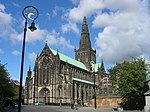Equestrian statue of William III, Glasgow
1735 sculpturesBuildings and structures in GlasgowCategory A listed buildings in GlasgowEquestrian statues in the United KingdomListed sculptures in Scotland ... and 4 more
Outdoor sculptures in ScotlandStatues in ScotlandStatues of William III of EnglandUnited Kingdom sculpture stubs

The equestrian statue of William III in Cathedral Square, Glasgow, is a 1735 work by an unknown sculptor.
Excerpt from the Wikipedia article Equestrian statue of William III, Glasgow (License: CC BY-SA 3.0, Authors, Images).Equestrian statue of William III, Glasgow
Castle Street, Glasgow Townhead
Geographical coordinates (GPS) Address Nearby Places Show on map
Geographical coordinates (GPS)
| Latitude | Longitude |
|---|---|
| N 55.8618 ° | E -4.23633 ° |
Address
Castle Street / Rottenrow
Castle Street
G4 0RB Glasgow, Townhead
Scotland, United Kingdom
Open on Google Maps









